Sigma 17-70 mm f/2.8-4.0 DC Macro OS HSM
3. Build quality and image stabilization
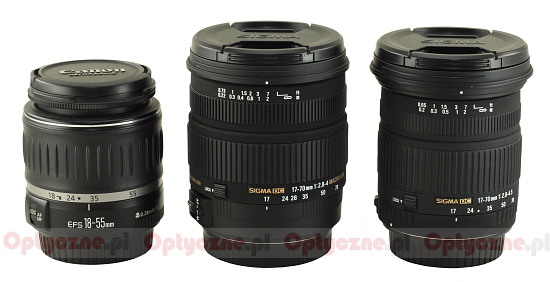 |
The following chart shows a comparison between the Sigma and other lenses with similar parameters, produced by rival companies. The Sigma is the heaviest and one of the biggest instruments of all, with the largest front element. It’s not a surprise, though, because the tested device is also the fastest of all - no other competitor from this chart features optical image stabilization and the Sony/Zeiss 16-80 mm, although with a better focal range, doesn’t have an ultrasonic autofocus motor.
Please Support UsIf you enjoy our reviews and articles, and you want us to continue our work please, support our website by donating through PayPal. The funds are going to be used for paying our editorial team, renting servers, and equipping our testing studio; only that way we will be able to continue providing you interesting content for free. |
- - - - - - - - - - - - - - - - - - - - - - - - - - - - - - - - - - - - - - - - - - - - - - - -
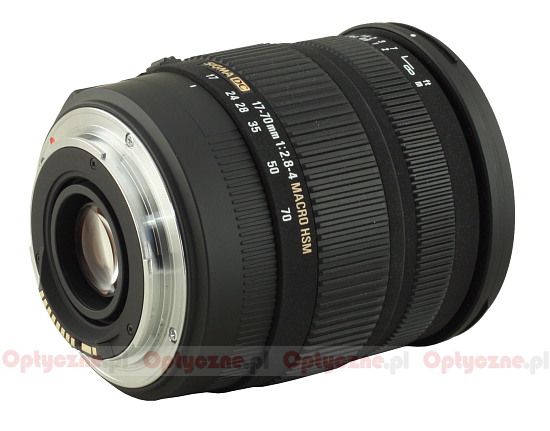 |
The Sigma 17–70 mm f/2.8–4.0 DC Macro OS HSM doesn’t belong to the highest Sigma EX series. Nevertheless, the lens is difficult to fault. It starts with a metal mount behind which, on the left, we find a stabilization switch (ON/OFF) and a focusing mode switch (AF/MF).
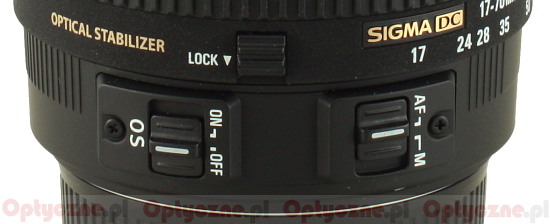 |
Next, we see a comfortable, big and ribbed zoom ring. It’s well-damped and it works evenly throughout the range. Moving from 17 to 70 mm makes the lens parameters (mount included) increase from 94 mm to 134 mm. Such an effect is connected with the telescopic tube (unfortunately made of plastic) on which the front element is extended. Everything works properly here though, we haven’t noticed any zoom creep tendencies. To be absolutely sure we still can use a LOCK switch which allows us to block the lens in a folded position at 17 mm.
Further on, we meet a quite big and convenient manual focus ring. There is a distance scale in feet and meters on it. You can work comfortably with it, one thing that we would complain about, though, is a bit too small resistance. You must get used to it – if you want to change the focus just slightly you must be very delicate indeed. Running through the scale takes approximately a 80-degree turn. The lens ends with a non-rotating filter thread with a diameter of 72 mm. As we mentioned filters here perhaps it would be a good thing if the company made a similar promotion as in the case of this lens’s predecessor, adding a good quality UV filter to the device free of charge.

The Sigma 17–70 mm f/2.8–4.0 DC Macro OS HSM is an optically complex instrument. It consists of as many as 17 elements in 13 groups. One element is made of low-dispersion ELD (Extraordinary Low Dispersion) glass and three other elements are aspherical (one hybrid element, two made using the “glass mold” technology). It is significantly better than in the case of its predecessor which had just one SLD (Special Low Dispersion) element and two ordinary aspherical ones. Inside the lens we can also find an aperture with seven diaphragm blades which can be closed down at 17 mm to f/22 and at 70 mm – to f/32.
If you want to compare both models, the old and the new, it’s worth noticing the change of speed at the longer end. The following chart shows the results at individual focal lengths.
|
|
|
|
|
|
|
|
|
|
| Sigma 17–70 mm f/2.8–4.5 DC Macro |
|
|
|
|
|
|
|
|
| Sigma 17–70 mm f/2.8–4.0 DC Macro OS HSM |
|
|
|
|
|
|
|
|
The buyer gets both caps and a petal-type lens hood included in box.
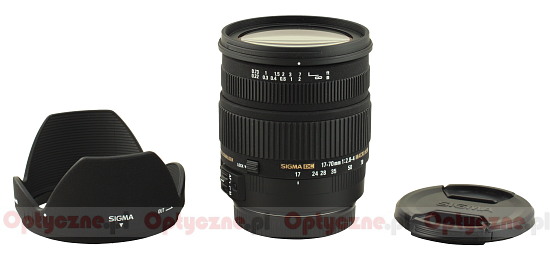 |
Stabilization
The producer claims that the optical stabilization system (OS), used in the Sigma 17-70 mm OS, works with the efficiency reaching 4 EV. We decided to check it. We set the focal length at 70 mm and, for every exposition time available in the range from 1/100 to 1/4 second, we took several dozen photos with the stabilization on and off. Then we calculated the percentage of blurred photos for every exposition time. The appropriate graph, presenting such a proportion which depends on the exposition time expressed in EV ( 0 EV is the equivalent of 1/80 second), can be seen below.
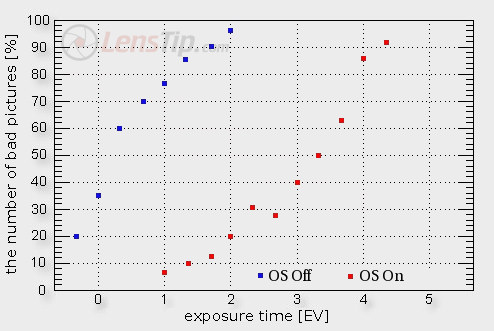
As you can notice the situation is good although we don’t see those promised 4 EV. Momentarily the stabilization is a bit above 3 EV and such a performance is really good – definitely better than in the case of other stabilized Sigma lenses, which usually showed a result of about 2 EV.






